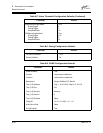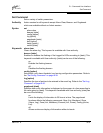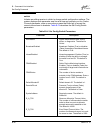
B – Command Line Interface
Securityset Command
59021-07 A B-35
D
Securityset Command
Manages security sets in the security database.
Authority Admin session and a Security Edit session. Refer to the ”Security Command” on
page B-32 for information about starting a Security Edit session. The Active,
Groups, and List keywords are available without an Admin session. You must
close the Security Edit session before using the Activate and Deactivate
keywords.
Syntax securityset
act
ivate [security_set]
active
add [security_set] [group_list]
copy [security_set_source] [security_set_destination]
create [security_set]
deac
tivate
del
ete [security_set]
groups [security_set]
list
remove [security_set] [group]
rename [security_set_old] [security_set_new]
Keywords activate [security_set]
Activates the security set given by [security_set]. This keyword deactivates the
active security set. Close the Security Edit session using the Security Save or
Security Cancel command before using this keyword.
active
Displays the name of the active security set. This keyword is available without an
Admin session.
add [security_set] [group_list]
Adds one or more groups given by [group_list] to the security set given by
[security_set]. Use a <space> to delimit multiple group names in [group_list]. A
security set can have a maximum of three groups with no more than one group of
each group type.
copy [security_set_source] [security_set_destination]
Creates a new security set named [security_set_destination] and copies into it the
membership from the security set given by [security_set_source].
create [security_set]
Creates the security set with the name given by [security_set]. A security set
name must begin with a letter and be no longer than 64 characters. Valid
characters are 0-9, A-Z, a-z, _, $, ^, and -. The security database supports a
maximum of 4 security sets.
deact
ivate
Deactivates the active security set. Close the Security Edit session before using
this keyword.


















